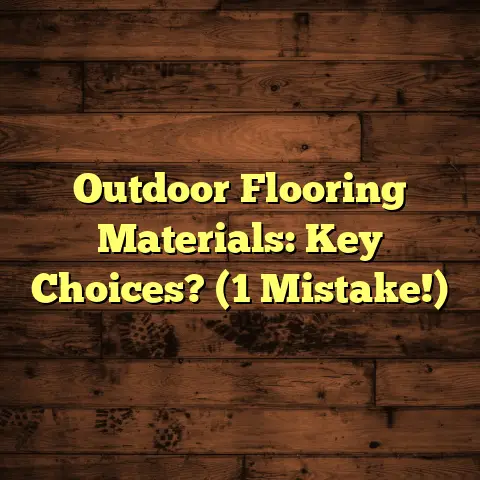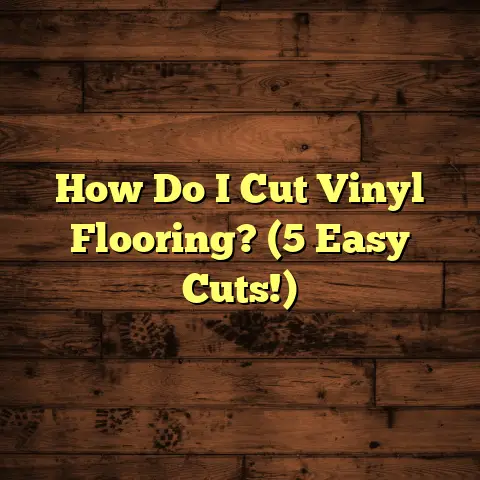Chair Mats For Hardwood? (4 Scratches To Avoid!)
And I’ve also seen the damage that can happen when they’re not properly protected.
Hardwood floors are a timeless addition to any home or office, exuding warmth and elegance.
But maintaining their pristine appearance can be tough, especially in high-traffic areas where rolling chairs are used often.
One of the most common issues I see is unsightly scratches that accumulate over time.
These scratches detract from the natural beauty of the wood.
These can come from chair wheels, dirt, debris, and even furniture itself.
Many people search for solutions to protect their floors without sacrificing aesthetic appeal.
That’s where chair mats come in!
In this article, I’ll explore the essential role of chair mats in safeguarding your hardwood floors.
I’ll delve into the specific types of scratches that can occur.
And I’ll highlight four key pitfalls to avoid when selecting and using chair mats.
By understanding these common issues, you’ll be better equipped to make informed choices.
Choices that protect your investment in hardwood flooring while maintaining a stylish and functional workspace.
Ready to dive in? Let’s get started!
Section 1: Understanding the
Importance of Chair Mats for
Hardwood Floors
1.1 The Role of Chair Mats
So, what exactly is a chair mat?
Simply put, it’s a protective barrier placed between your rolling chair and your hardwood floor.
Its main purpose is to prevent scratches, scuffs, and other damage caused by the constant movement of the chair.
Think of it as a shield for your floor!
Benefits of using chair mats:
-
Protection: Prevents scratches, dents, and scuffs.
-
Ergonomics: Makes it easier to roll your chair, reducing strain on your body.
-
Aesthetics: Preserves the beauty of your hardwood floors.
-
Cost-Effective: Cheaper than repairing or replacing damaged floors.
There are many types of chair mats available, each with its own pros and cons.
Let’s take a quick look at some of the most common ones:
-
Polycarbonate: Durable and transparent, allowing the beauty of your floor to show through.
-
PVC (Vinyl): More affordable, but can be less durable and may contain harmful chemicals.
-
Glass: Very durable and stylish, but also the most expensive.
-
Wood: Matches your floor, but may not provide enough protection.
-
Bamboo: Eco-friendly and durable, but can be prone to splintering.
1.2 The Impact of Scratches on
Hardwood Floors
Scratches are more than just a cosmetic issue. They can significantly impact the appearance and value of your hardwood floors.
Think about it: a floor riddled with scratches looks worn and neglected.
This can detract from the overall aesthetic of your home or office.
And it can even lower the resale value of your property.
According to the National Association of Realtors, well-maintained hardwood floors can increase a home’s selling price by as much as 2.5%.
But scratched floors can have the opposite effect.
Long-term consequences of neglecting floor protection:
-
Reduced aesthetic appeal.
-
Lower property value.
-
Costly repairs or replacements.
-
Increased susceptibility to moisture damage.
-
Unpleasant living or working environment.
Now, let’s talk about the costs associated with repairing scratched hardwood.
Depending on the severity of the damage, you might be looking at:
-
DIY Scratch Repair Kit: \$20-\$50
-
Professional Buffing and Recoating: \$1-\$3 per square foot
-
Full Sanding and Refinishing: \$3-\$8 per square foot
-
Floor Replacement: \$5-\$15 per square foot
As you can see, preventing scratches in the first place is much more cost-effective than dealing with the aftermath.
Section 2: Identifying Common
Types of Scratches
Before we dive into how to avoid scratches with chair mats, let’s take a look at the different types of scratches you might encounter.
2.1 Surface Scratches
Surface scratches are the most common type of damage.
They’re usually shallow and only affect the top layer of the floor’s finish.
Causes of surface scratches:
-
Small debris under chair wheels.
-
Pet claws.
-
Moving furniture.
-
High heels.
-
Everyday foot traffic.
Think about those tiny grains of sand that get tracked into your house.
They can act like sandpaper under your chair wheels, causing fine scratches over time.
2.2 Deep Scratches
Deep scratches penetrate through the finish and into the wood itself.
These are more noticeable and harder to repair than surface scratches.
Causes of deep scratches:
-
Sharp objects dragged across the floor.
-
Heavy furniture being moved without protection.
-
Aggressive pet activity.
-
Accidental gouges from tools or other equipment.
Deep scratches can compromise the integrity of the floor, making it more susceptible to moisture damage and further wear.
2.3 Scuff Marks
Scuff marks are different from scratches.
They’re usually caused by the transfer of material from one surface to another.
Think of them as smudges or smears on your floor.
Common sources of scuff marks:
-
Rubber soles of shoes.
-
Plastic chair legs.
-
Dragging boxes or other items.
While scuff marks aren’t as damaging as scratches, they can still detract from the appearance of your floor.
Fortunately, they’re usually easy to remove with a good cleaning product.
2.4 Gouges
Gouges are the most severe type of damage.
They’re deep indentations or chunks missing from the floor.
How gouges occur:
-
Dropping heavy objects.
-
Dragging sharp or pointed items.
-
Severe impact from furniture or equipment.
Gouges can be difficult to repair and may require professional attention.
In some cases, the damaged section of the floor may need to be replaced.
Section 3: Four Key Scratches to
Avoid with Chair Mats
Now that we’ve covered the basics of chair mats and the types of scratches they’re meant to prevent, let’s get into the nitty-gritty.
Here are four key scratches you need to avoid when using chair mats on hardwood floors:
3.1 Scratch #1: Inappropriate
Chair Wheels
Did you know that the type of chair wheels you use can have a huge impact on your hardwood floors?
It’s true!
Hard, plastic wheels are notorious for causing scratches.
They don’t have any give, so they grind against the floor, especially if there’s any dirt or debris present.
The importance of selecting the right wheels:
-
Protect your floors from scratches.
-
Improve chair mobility.
-
Reduce noise.
-
Enhance comfort.
Materials to avoid:
-
Hard plastic.
-
Metal.
-
Wheels with sharp edges or ridges.
Safe alternatives:
-
Soft rubber or polyurethane wheels.
-
Carpet casters (for use on chair mats).
-
Wheels with a smooth, rounded surface.
I always recommend soft rubber or polyurethane wheels for hardwood floors.
They’re gentle on the surface and provide excellent traction.
You can easily replace your existing wheels with these safer options.
They’re available at most office supply stores and online retailers.
3.2 Scratch #2: Low-Quality
Chair Mats
Not all chair mats are created equal.
Using a low-quality chair mat can actually do more harm than good.
Cheap mats are often made from thin, brittle plastic that cracks and breaks easily.
These cracks can create sharp edges that scratch your floor.
Risks associated with inferior chair mats:
-
Cracking and breaking.
-
Sharp edges that scratch the floor.
-
Lack of adequate protection.
-
Slipping and sliding.
-
Off-gassing of harmful chemicals.
Signs that a chair mat may be damaging your floor:
-
Visible scratches or scuff marks under the mat.
-
Cracks or breaks in the mat.
-
The mat is slipping or sliding.
-
The mat is emitting a strong odor.
Recommendations for quality chair mats:
-
Choose a mat made from durable materials like polycarbonate or tempered glass.
-
Select the appropriate thickness for your floor type and chair weight (usually between 1/8″ and 1/4″).
-
Look for a mat with a smooth, non-slip backing.
-
Consider a mat with beveled edges for easy transitions.
I’ve found that polycarbonate mats offer the best combination of durability, transparency, and affordability.
They’re also resistant to cracking and discoloration.
3.3 Scratch #3: Lack of Regular
Maintenance
Even the best chair mat won’t protect your floor if you don’t maintain it properly.
Dirt, dust, and debris can accumulate under the mat, acting like sandpaper and causing scratches over time.
How neglecting maintenance can lead to scratches:
-
Accumulation of dirt and debris under the mat.
-
Scratches caused by trapped particles.
-
Reduced effectiveness of the mat.
-
Unsanitary environment.
The role of cleaning and care:
-
Removes dirt and debris.
-
Prevents scratches.
-
Extends the life of the mat.
-
Maintains a clean and healthy environment.
Tips for maintaining chair mats and hardwood floors:
-
Vacuum or sweep your hardwood floor regularly.
-
Lift and clean your chair mat at least once a week.
-
Use a mild soap and water solution to clean the mat.
-
Avoid using harsh chemicals or abrasive cleaners.
-
Dry the mat thoroughly before replacing it.
I recommend using a vacuum with a soft brush attachment to clean your hardwood floors.
This will help prevent scratches caused by the vacuum itself.
3.4 Scratch #4: Improper
Placement of Chair Mats
The way you position your chair mat can also affect its ability to protect your floor.
If the mat is too small or not positioned correctly, your chair wheels may roll off the edge and onto the bare floor.
The importance of correct mat placement:
-
Ensures full coverage of the area where the chair rolls.
-
Prevents chair wheels from rolling onto the bare floor.
-
Reduces the risk of scratches.
-
Improves ergonomics.
Common mistakes to avoid:
-
Using a mat that is too small.
-
Placing the mat in the wrong location.
-
Not accounting for the full range of chair movement.
-
Ignoring the shape of the workspace.
The impact of mat size and coverage:
-
Larger mats provide more coverage and better protection.
-
The mat should extend beyond the area where the chair is typically used.
-
Consider the shape of your workspace when choosing a mat size and shape.
I always recommend measuring the area where your chair rolls to determine the appropriate mat size.
You should also consider the shape of your workspace.
For example, if you have an L-shaped desk, you might need a custom-shaped mat to provide adequate coverage.
Section 4: Conclusion: Making
Informed Choices
So, there you have it!
Everything you need to know about chair mats and how to avoid those pesky scratches on your beautiful hardwood floors.
Protecting your hardwood floors is crucial to preserving their beauty and durability.
By understanding the types of scratches that can occur and the specific pitfalls to avoid, you can take proactive steps to ensure your floors remain in top condition.
Chair mats, when chosen wisely and used correctly, can significantly reduce the risk of scratches and enhance the overall functionality of any workspace.
Remember, investing in a quality chair mat and maintaining it properly is a small price to pay compared to the cost of repairing or replacing damaged hardwood floors.
So, take the time to do your research, choose the right mat for your needs, and follow the tips I’ve shared in this article.
Your hardwood floors will thank you for it!





